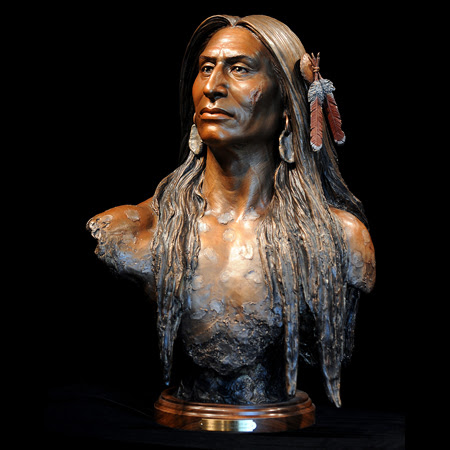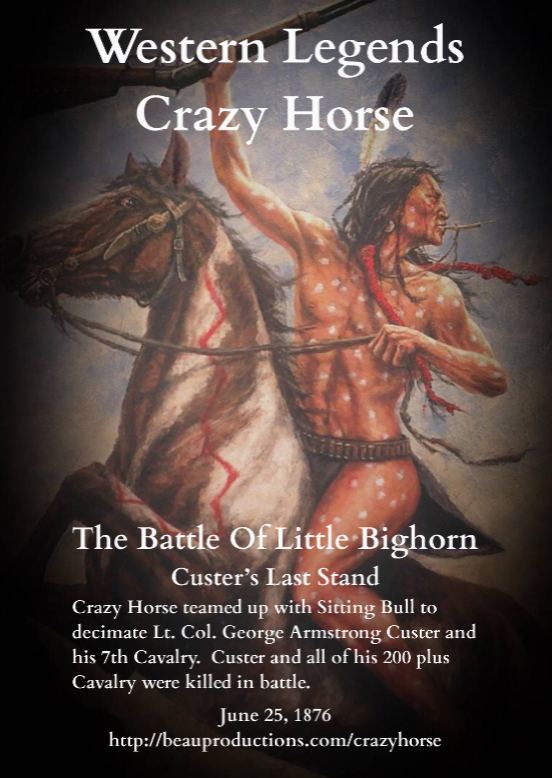BEAU PRODUCTIONS HISTORICAL WEBSITES
Western Legends

 CRAZY HORSE  Courageous. Wise. Steadfast. There are few names in Native American history as revered as Crazy Horse (Tashunkewitko). The exact date of his birth is unclear, probably sometime around 1840. At birth he was given the name Light Hair or Curly Hair. According to Chief Black Elk, a second cousin, Crazy Horse took his adult name after experiencing a vision in which he saw a horse strangely dancing about like a creature of shadow. He believed this vision gave him great power, so much so that he could go into battle and not be injured. And in fact, Crazy Horse survived many, many battles over the years. The son of a medicine man, Crazy Horse spent the early years of his life raised by the women of his tiospaye or family. Once Crazy Horse was old enough he set out on one of the most important rites of passage to a Lakota warrior, the Vision Quest (Hanbleceya) crying for a vision or to pray for a spiritual experience. This rite of passage gave Crazy Horse guidance on his path in life. He went alone into the hills for four days without food or water and cried for a dream to the great spirits. By the time Crazy Horse was in his mid-teens he was already a full-fledged warrior. His bravery and prowess in battle were well-known by the Lakota people. He rode into battle with a single hawk feather in his hair, a rock behind his ear, and a lightning symbol on his face. The symbols and rituals that went into preparing for war provided the warrior power and protection. Old West fans, History Buffs and Educators In 1876, Crazy Horse led a band of Lakota warriors against Custer's Seventh U.S. Cavalry battalion. They called this the Battle of the Little Bighorn also known as Custer's Last Stand and the Battle of the Greasy Grass. Custer, 9 officers, and over 200 enlisted men, all lay dead after the fighting was over. According to tribes who participated in the battle only 32 Indians were killed. Without Crazy Horse and his followers the battle's outcome would have been much different as Crazy Horse was integral in stopping reinforcements from arriving. After defeating Custer at Little Big Horn in June, 1876, Crazy Horse continued to resist U.S. forces. It was after the Battle of the Little Bighorn that the United States Government would send scouts to round up any Northern Plains tribes who resisted. This forced many Indian Nations to move across the country, always followed by soldiers, until starvation or exposure would force them to surrender. This is also how Sitting Bull of the Hunkpapa Lakota were forced into submission. In 1877, with food running out and under a flag of truce, Crazy Horse went to Fort Robinson. But, Negotiations with U.S. Military leaders stationed at the Fort broke down. Eyewitnesses blame the breakdown in negotiations on the translator who incorrectly translated what Crazy Horse said. Crazy Horse was quickly escorted toward the jail. Once he realized that the commanding officers were planning on imprisoning him, he struggled and drew his knife. As Crazy Horse continued to free himself, an infantry guard made a successful lunge with a bayonet and mortally wounded the great warrior. Crazy Horse died shortly after the mortal wound was inflicted. There are different accounts putting the date of his death around midnight September 5, 1877.  It is a well-known fact that Crazy Horse refused to have his picture or likeness taken. Crazy Horse lived under the assumption that by taking a picture a part of his soul would be taken and his life would be shortened. The popular response to photograph requests would be, "Would you imprison my shadow too?" There are no photos of Crazy Horse that can be 100% validated. |
A must have collectable for all Old West Fans!
Western Legends Historical Collectable Cards
If you are interested in our Western Legends Historical Cards (same as baseball cards)
as shown below you may purchase on eBay for as little as $8.00 or less.
Click or tap on card image if interested

